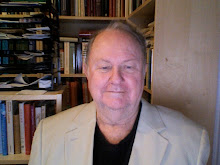For a long time the term Gothic (and earlier its synonym "German") was used indiscriminately to cover the entire Middle Ages. As nothing of value happened during the Dark Ages, it was not necessary to observe chronological niceties.
During the 17th century, however, architects in England and France began to notice differences between what they termed earlier Gothic and later Gothic. The one featured the round arch, the other the pointed arch. The earlier buildings preferred massive walls, the later one, light, soaring forms.
It is difficult to discuss a phenomenon without a name, and this advance came in the second decade of the 19th century, when the problem was tackled by William Gunn and Charles de Gerville. The former proposed (in 1819) the English term "Romanesque," while Gerville advanced the somewhat confusiong word "roman." Common to both designations is a sense of kinship with imperial Roman architecture, witness the round arch. (There is a monograph on these acts of naming by Tina Waldeier Bizzarro.)
Several examples served to illustrate our current understanding of Romanesque and its difference from Gothic. The Morgan Madonna in the Met illustrates the compact, obdurate, almost squat forms preferred in sculpture, while its Gothic companion in Boston (ca. 1200) revealed the delicacy and soaring ascent of Gothic.
Several manuscript illuminations took us further, The image of the Expulsion from Eden from the St. Albans Psalter showed a creative interplay with the three cells delimited by the arches. The St. Amandus image displayed a mor doctrinaire approach to compartmentation.
Particularly revealing were some images from a manuscript in Wiesbaden (no longer extant) attributed to the polymath Hildegard of Bingen. Among other things, she showed an affinity for central-plan, mandala like compositions. There is an interesting affinity with the pioneering Swedish abstractionist Hilma af Klint.
That playful aspects were not absent from Romanesque is seen in two initials from Citeaux. Such forms descend, of course, from Merovingian initials, but are now much more mature.
The Friedenskirche in Potsdam (completed in 1848) is a token of the Romanesque revival, which began in Germany in the 1840s. A distant echo of this trend is the Judson Memorial Church on Washington Square (1892). NYC's most prominent hommage to the Romanesque is the Cloisters, consisting of portions of medieval buildings (mainly French and Spanish), "kidnapped" for this purpose.
A more creative approach to Romanesque appears in the work of America's first world-class architect Henry Hobson Richardson. Richardson had learned a great deal about Romanesque during his years in France (where he waited out the Civil War). In Pittsburgh his Allegheny Jail and Courthouse showed a new use for Romanesque: carceral architecture. The so-called "Syrian arch," with is massive, spiky voussoirs, initiated a trend imitated by his successors Louis Sullivan and Frank Lloyd Wright.
More orthodox, perhaps, is Richardson's Trinity Church in Boston (begun 1875). This draws on the rich decorative vocabulary of mature French and Spanish Romanesque.
Eventually a more austere model of Romanesque came into vogue, as seen in the abbey of St. Philibert at Tournus. In his early career Le Corbusier had been interested in Gothic. At the end of his career he turned to Cistertian austerity and (I would argue) Romanesque, as seen in his monastery of La Tourette. (See my recent article in Gesta.)
Other Romanesque affinities were seen in paintings by Mario Sironi and Georgia O'Keeffe.
Finally, Wright's Unity Temple in Oak Park (1906) was named as a (possibly) Romanesquoid building.
For a long time the question of the origins and date of Gothic remained uncertain. With the "liberation" of Romanesque from the Gothic embrace, this question seemed more earnest. It was taken for granted that Gothic had originated in the forests of northern Europe, being this a particular item in the Germanic-Emglish repertoire. Others proposed that Gothic architecture was quintessentially Christian, an explanation not incompatible with the previous one.
It was left for an obscure German architectural historian, Franz Mertens, to prove (in 1842) that Gothic was actually French. He did this by carefully studying the dates of the earliest buildings, an endeavor that pointed to the Ile de France, specifically the abbey of St. Denis. Today there is a general consensus that this pinpointing is correct. Gothic was invented by Abbot Suger at St. Denis, ca. 1144.
The origins of Romanesque are more diffuse. They were not clarified until the Catalan architect and historian Puig i Cadafalch made his fundamental studies a century ago. Puig showed that proto-Romanesque emerged in the 11th century in an arc stretching from Catalonia, through southern France, to Lombardy in northern Italy. These provinces had been strongly imbued with the Roman heritage.
Monday, November 5, 2007
Subscribe to:
Post Comments (Atom)

No comments:
Post a Comment